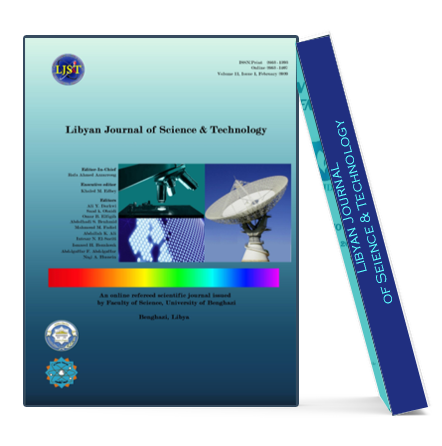Bacterial contamination of fast food shawarma sandwiches in local restaurants in Ben- ghazi city, Libya 1
DOI:
https://doi.org/10.37376/ljst.v11i2.2418Abstract
Sandwiches are widely consumed as part of the international food culture, therefore, the investigation of microbiological quality and hygienists are essential steps for risk factor determination of food-borne illnesses. This study investigated the bacterial contamination in 151 chicken shawarma sandwiches randomly selected from 19 restaurants located in four different regions in the city of Benghazi, including North, South, East, and the City center. The results showed that 89.4% of chicken shawarma sandwiches samples were contaminated with bacteria. The bacterial diversity showed that Klebsiella pneumoniae was the predominant bacterial species isolated from the sandwiches (24.5%), thus, it has been suggested to represent the highest source of bacterial contamination in the screened samples. The latter bacteria was followed by Escherichia coli (19.9%), Citrobacter freundii (18.8%), Bacillus sp. (9.9%), Proteus mirabilis(8.6%), Enterobactercloacae (7.9%), Pseudomonas aeruginosa (6%), Enterobacter aeruginosa (4%) and Staphylococcus aureus (0.7%). Quantification of the bacterial contamination using total plate count has revealed that Bacillus sp 1.9×105 cfu/g, E. cloacae1.8×105cfu/g, C. freundii 1.4×105 cfu/g, K. 7.3×104 cfu/g, E. coli 4.5×104 cfu/g and E. aerogenes 4.2×103 cfu/g. The bacterial sensitivity to the antibiotics showed that all tested pathogens were mostly resistant to Cloxacillin, Amoxicillin, Metronidazole and Cephalothin (86.7% to 100% of resistant). Only P. aeruginosa, Enterobacter sp., and P. mirabilis showed complete resistanceto Cefoxitin. Bacillus sp. was mostly resistant to the tested antibiotics compare to S. aureus. The results of this study demonstrated that the bacterial contamination in the tested sandwiches were relatively high and were produced under low hygienic conditions. This was supported by the finding that the increased bacterial count in the sandwiches and the high resistant level to antibiotic have indicated a high risk factor for acquiring food-borne illnesses.










 LJST Copy rights form
LJST Copy rights form


